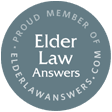Sometimes, for tax purposes or other reasons, it is appropriate to change a Trust’s terms, but the person who set up the trust can’t, either because that person is now disabled, incompetent or has passed, or the Trust itself is “irrevocable”.
There are ways to effectively reform or modify the trust, some of which may involve a private agreement between the Trustees and beneficiaries and others that may require court involvement. We can assist you with such a trust modification or reformation.
Trust Basics
To set up a trust, a “settlor” (sometimes called a “grantor”) creates a trust document. The trust document names a trustee and beneficiaries and also states the purpose and terms of the trust. The settlor then transfers property into the trust, and the trustee takes care of (or distributes) the property according to the terms of the document. Trust can be revocable or irrevocable.
- Revocable trusts can be changed or cancelled by the settlor at any time.
- Generally, irrevocable trusts cannot be changed or terminated. There are some exceptions, depending on the type of trust and its terms. For example, in some cases you may be able to change an irrevocable trust if all the beneficiaries agree, if the change is in the best interest of the beneficiaries, or if another legal exception applies.
Two common trust categories are “living trusts” and “testamentary trusts”. Here are some details about modifying or terminating these trusts. Some trusts can be modified or terminated, others cannot, it depends on the terms of the trust and whether the trust is revocable. See california irrevocable trust form.
Living Trusts
Living trusts are usually created to avoid probate and they are almost always revocable. So, the settlor of a living trust usually has the power to change or terminate the trust. Indeed, the power to change or terminate the trust is one of the benefits of this type of trust. Settlors usually make a living trust to keep control of trust property during their lives, and to avoid probate when they die. If you have just small changes to make to your living trust, it usually makes sense to add an amendment or to restate the trust, rather than revoking it and writing a new one. This is because making a new trust requires you to transfer all trust property to the new trust and this can be a substantial amount of work. Amending the trust involves adding pages to the trust that describes the changes. Amending a trust is sufficient for very small and simple changes, like changing the name of a trustee or beneficiary. For more substantial changes, restating the trust is usually better because you restate the entire trust, including the changes, so there is less room for ambiguity. Read more about amending a living trust in california.
Generally, a living trust cannot be changed or revoked after the death of the settlor. One more thing – although a “revocable” trust may generally be amended, if the settlor has lost capacity (or, in the case of a married couple, one of them has lost capacity), many trusts then become analogous to an irrevocable trust, because the settlor can no longer sign the amendment. In appropriate circumstances, we have solved that problem by creative trust drafting, as well as certain provisions in the settlor’s power of attorney, which give the settlor’s agent the power to amend the document. On numerous occasions, this has saved our clients the expense and insecurity of petitioning a court to make needed trust modifications. Check for restatement of trust california sample.
Testamentary Trusts
A testamentary trust is a trust that is created when the settlor dies. For example, when a will maker includes a trust as part of a will, the trust doesn’t take effect until the will maker dies. This type of testamentary trust is often used to set up trusts for minors, so that someone is named to help manage a child’s inheritance, or even for spouses, to assure funds are available for an ill spouse who requires long-term care. If you include a testamentary trust in your will, you can modify it or revoke it at any time, but after you die it becomes irrevocable. Read more about lost trust documents california.
The trustee or beneficiaries may be able to modify the trust after your death, but under limited circumstances, for example, if the trust cannot achieve its intended purpose. This sometimes happens when the amount of money in the trust is different than expected or when the beneficiary’s needs change. A testamentary trust usually states when it will end, for example, when the beneficiary reaches a certain age or when a specific purpose is achieved. Check for free living trust amendment form california.
How do we fix the issue of trust irrevocability?
Typically, in order to modify an irrevocable trust, one would need to initiate a court procedure and request that the court allow the change or modification. In order to prevent our clients from having to spend thousands of dollars in court costs and legal fees in order to modify an irrevocable trust, we have incorporated “Trust Protector” provisions into our trust documents. This means that if the irrevocable trust needs to be updated, it can be modified WITHOUT an expensive court procedure, by the appointment of a Trust Protector, who then has the authority under the document, to update the trust. This is just one of many instances where expert drafting saves our clients substantial costs, delays, and frustration. You may also check how to terminate an irrevocable trust in california.
Please be advised that the information on this site is not meant to be construed as legal advice. If you need legal advice, or for more information about modifying or reforming a Trust Attorney in Los Angeles, please contact our office at (562) 526-6941 for a 30-minute consultation!







